Buffalo Soldier
Buffalo Soldiers originally were members of the 10th Cavalry Regiment of the United States Army, formed on September 21, 1866, at Fort Leavenworth, Kansas. This nickname was given to the Black Cavalry by Native American tribes who fought in the Indian Wars. The term eventually became synonymous with all of the African-American regiments formed in 1866:
- 9th Cavalry Regiment
- 10th Cavalry Regiment
- 24th Infantry Regiment
- 25th Infantry Regiment
- Second 38th Infantry Regiment
| Buffalo Soldiers | |
|---|---|
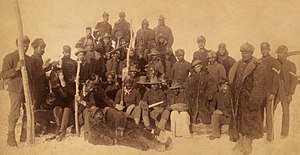 Buffalo Soldiers of the 25th Infantry Regiment in 1890 | |
| Active | 1866–1951 |
| Country | |
| Branch | 9th Cavalry Regiment |
| Nickname(s) | "Buffalo Soldiers" |
| Colors | Blue |
| Engagements | American Indian Wars Spanish–American War Philippine–American War Mexican Border War World War I World War II |
Although several African-American regiments were raised during the Civil War as part of the Union Army (including the 54th Massachusetts Volunteer Infantry and the many United States Colored Troops Regiments), the "Buffalo Soldiers" were established by Congress as the first peacetime all-black regiments in the regular U.S. Army.[1] On September 6, 2005, Mark Matthews, the oldest surviving Buffalo Soldier, died at the age of 111. He was buried at Arlington National Cemetery.[2]
Etymology
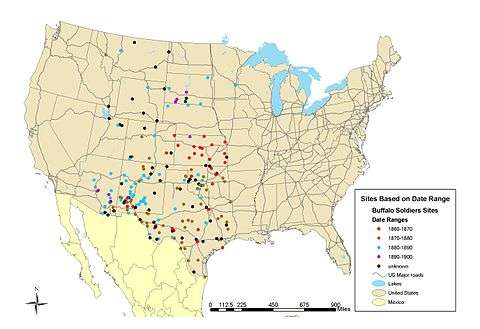
Sources disagree on how the nickname "Buffalo Soldiers" began. According to the Buffalo Soldiers National Museum, the name originated with the Cheyenne warriors in the winter of 1877, the actual Cheyenne translation being "Wild Buffalo". However, writer Walter Hill documented the account of Colonel Benjamin Grierson, who founded the 10th Cavalry regiment, recalling an 1871 campaign against Comanches. Hill attributed the origin of the name to the Comanche, due to Grierson's assertions. The Apache used the same term ("We called them 'buffalo soldiers,' because they had curly, kinky hair ... like bisons") a claim supported by other sources.[3][4][5][6] Another possible source could be from the Plains Indians who gave them that name because of the bison coats they wore in winter.[7] The term Buffalo Soldiers became a generic term for all black soldiers. It is now used for U.S. Army units that trace their direct lineage back to any of the African-American regiments formed in 1866.
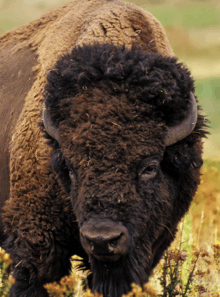
Service
During the Civil War, the U.S. government formed regiments known as the United States Colored Troops, composed of black soldiers and Native Americans. The USCT was disbanded in the fall of 1865. In 1867 the Regular Army was set at ten regiments of cavalry and 45 regiments of infantry. The Army was authorized to raise two regiments of black cavalry (the 9th and 10th (Colored) Cavalry) and four regiments of black infantry (the 38th, 39th, 40th, and 41st (Colored) Infantry), who were mostly drawn from USCT veterans. The first draft of the bill that the House Committee on Military Affairs sent to the full chamber on March 7, 1866 did not include a provision for regiments of black cavalry, however, this provision was added by Senator Benjamin Wade prior to the bill's passing on July 28, 1866.[8] In 1869 the Regular Army was kept at ten regiments of cavalry but cut to 25 regiments of Infantry, reducing the black complement to two regiments (the 24th and 25th (Colored) Infantry). The 38th and 41st were reorganized as the 25th, with headquarters in Jackson Barracks in New Orleans, Louisiana, in November 1869. The 39th and 40th were reorganized as the 24th, with headquarters at Fort Clark, Texas, in April 1869. The two black infantry regiments represented 10 percent of the size of all twenty-five infantry regiments. Similarly, the two black cavalry units represented 20 percent of the size of all ten cavalry regiments.[8]
During the peacetime formation years (1865-1870), the black infantry and cavalry regiments were composed of black enlisted soldiers commanded by white commissioned officers and black noncommissioned officers. These included the first commander of the 10th Cavalry Benjamin Grierson, the first commander of the 9th Cavalry Edward Hatch, Medal of Honor recipient Louis H. Carpenter, and Nicholas M. Nolan. The first black commissioned officer to lead the Buffalo Soldiers and the first black graduate of West Point, was Henry O. Flipper in 1877.
From 1870 to 1898 the total strength of the US Army totaled 25,000 service members with black soldiers maintaining their 10 percent representation.[8]
History
Indian Wars
From 1866 to the early 1890s, these regiments served at a variety of posts in the Southwestern United States and the Great Plains regions. They participated in most of the military campaigns in these areas and earned a distinguished record. Thirteen enlisted men and six officers from these four regiments earned the Medal of Honor during the Indian Wars. In addition to the military campaigns, the Buffalo Soldiers served a variety of roles along the frontier, from building roads to escorting the U.S. mail. On April 17, 1875, regimental headquarters for the 10th Cavalry was transferred to Fort Concho, Texas. Companies actually arrived at Fort Concho in May 1873. The 9th Cavalry was headquartered at Fort Union from 1875 to 1881.[9] At various times from 1873 through 1885, Fort Concho housed 9th Cavalry companies A–F, K, and M, 10th Cavalry companies A, D–G, I, L, and M, 24th Infantry companies D–G, and K, and 25th Infantry companies G and K.[10] From 1880 to 1881, portions of all four of the Buffalo Soldier regiments were in New Mexico pursuing Victorio and Nana and their Apache warriors in Victorio's War.[11] The 9th Cavalry spent the winter of 1890 to 1891 guarding the Pine Ridge Reservation during the events of the Ghost Dance War and the Wounded Knee Massacre. Cavalry regiments were also used to remove Sooners from native lands in the late 1880s and early 1890s.
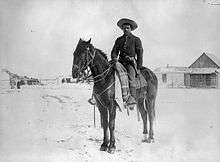
In total, 23 Buffalo Soldiers received the Medal of Honor during the Indian Wars.[12]
Johnson County War
A lesser known action was the 9th Cavalry's participation in the fabled Johnson County War, an 1892 land war in Johnson County, Wyoming, between small farmers and large, wealthy ranchers. It culminated in a lengthy shootout between local farmers, a band of hired killers, and a sheriff's posse. The 6th Cavalry was ordered in by President Benjamin Harrison to quell the violence and capture the band of hired killers. Soon afterward, however, the 9th Cavalry was specifically called on to replace the 6th. The 6th Cavalry was swaying under the local political and social pressures and was unable to keep the peace in the tense environment.
The Buffalo Soldiers responded within about two weeks from Nebraska, and moved the men to the rail town of Suggs, Wyoming, creating "Camp Bettens" despite a hostile local population. One soldier was killed and two wounded in gun battles with locals. Nevertheless, the 9th Cavalry remained in Wyoming for nearly a year to quell tensions in the area.[13][14]
1898–1918
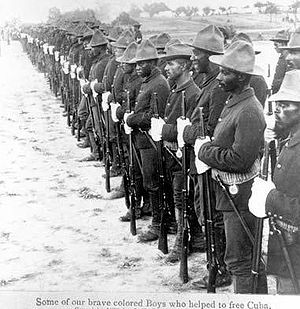
After most of the Indian Wars ended in the 1890s, the regiments continued to serve and participated in the 1898 Spanish–American War (including the Battle of San Juan Hill) in Cuba, where five more Medals of Honor were earned.[15][16]
The men of the Buffalo Soldiers were the only African Americans that fought in Cuba during the war.[17] Additionally, the Sixth Massachusetts Volunteer Infantry Regiment had a company of African-American soldiers, company L, that saw action in Puerto Rico.[18] Up to 5,000 "Black men" enlisted in volunteer regiments in the Spanish–American War in Alabama, Illinois, Kansas, North Carolina, Ohio and Virginia, and some had all black officers.[19] Several other African-American regiments of United States Volunteer Infantry (USVI) were formed and nicknamed "Immune Regiments", as they were mistakenly believed to be resistant to tropical diseases, but only the Ninth Immunes served overseas in the war.[20][21]
The Buffalo Soldiers regiments also took part in the Philippine–American War from 1899 to 1903 and the 1916 Mexican Expedition.[15][16] There was strong Opposition to War in the Philippines among African Americans.[22] Many black soldiers established a rapport with "the brown-skinned natives on the islands," and an unusually large number of black troops deserted during the campaign, some of whom joined the Filipino rebels, of whom the most famous was the celebrated David Fagen.[23][24]
In 1918, the 10th Cavalry fought at the Battle of Ambos Nogales during the First World War, where they assisted in forcing the surrender of the federal Mexican and Mexican militia forces.[15][16][25]
Buffalo soldiers fought in the last engagement of the Indian Wars, the small Battle of Bear Valley in southern Arizona which occurred in 1918 between U.S. cavalry and Yaqui natives.[15][16]
Park rangers
Another little-known contribution of the Buffalo Soldiers involved eight troops of the 9th Cavalry Regiment and one company of the 24th Infantry Regiment who served in California's Sierra Nevada as some of the first national park rangers. In 1899, Buffalo Soldiers from Company H, 24th Infantry Regiment briefly served in Yosemite National Park, Sequoia National Park, and General Grant (Kings Canyon) National Parks.[26]
U.S. Army regiments had been serving in these national parks since 1891, but until 1899, the soldiers serving were white. Beginning in 1899, and continuing in 1903 and 1904, African American regiments served during the summer in the second- and third-oldest national parks in the United States (Sequoia and Yosemite). Because these soldiers served before the National Park Service was created (1916), they were "park rangers" before the term was coined.
A lasting legacy of the soldiers as park rangers is the Ranger hat (popularly known as the Smokey Bear hat). Although not officially adopted by the Army until 1911, the distinctive hat crease, called a Montana peak, (or pinch) can be seen being worn by several of the Buffalo Soldiers in park photographs dating back to 1899. Soldiers serving in the Spanish–American War began to recrease the Stetson hat with a Montana "pinch" to better shed water from the torrential tropical rains. Many retained that distinctive crease upon their return to the U.S. The park photographs, in all likelihood, show Buffalo Soldiers who were veterans from that 1898 war.
One particular Buffalo Soldier stands out in history: Captain Charles Young, who served with Troop "I", 9th Cavalry Regiment in Sequoia National Park during the summer of 1903. Charles Young was the third African American to graduate from the United States Military Academy. At the time of his death, he was the highest-ranking African American in the U.S. military. He made history in Sequoia National Park in 1903 by becoming Acting Military Superintendent of Sequoia and General Grant National Parks. Charles Young was also the first African American superintendent of a national park. During Young's tenure in the park, he named a giant sequoia for Booker T. Washington. Recently, another giant sequoia in Giant Forest was named in Captain Young's honor. Some of Young's descendants were in attendance at the ceremony.[27]
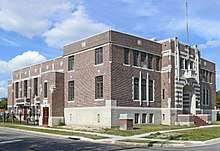
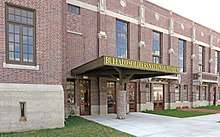
.jpg)
In 1903, 9th Cavalrymen in Sequoia built the first trail to the top of Mount Whitney, the highest mountain in the contiguous United States. They also built the first wagon road into Sequoia's Giant Forest, the most famous grove of giant sequoia trees in Sequoia National Park.
In 1904, 9th Cavalrymen in Yosemite built an arboretum on the South Fork of the Merced River in the southern section of the park. This arboretum had pathways and benches, and some plants were identified in both English and Latin. Yosemite's arboretum is considered to be the first museum in the National Park System. The NPS cites a 1904 report, where Yosemite superintendent (Lt. Col.) John Bigelow, Jr. declared the arboretum "To provide a great museum of nature for the general public free of cost ..." Unfortunately, the forces of developers, miners, and greed cut the boundaries of Yosemite in 1905 and the arboretum was nearly destroyed.[28]
In the Sierra Nevada, the Buffalo Soldiers regularly endured long days in the saddle, slim rations, racism, and separation from family and friends. As military stewards, the African American cavalry and infantry regiments protected the national parks from illegal grazing, poaching, timber thieves, and forest fires. Yosemite Park Ranger Shelton Johnson researched and interpreted the history in an attempt to recover and celebrate the contributions of the Buffalo Soldiers of the Sierra Nevada.[29]
West Point
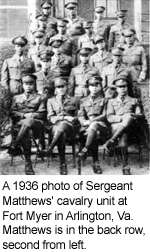
On March 23, 1907, the United States Military Academy Detachment of Cavalry was changed to a "colored" unit. This had been a long time coming. It had been proposed in 1897 at the "Cavalry and Light Artillery School" at Fort Riley, Kansas that West Point cadets learn their riding skills from the black noncommissioned officers who were considered the best. The 100-man detachment from the 9th,[30] and 10th[31] Cavalry served to teach future officers at West Point riding instruction, mounted drill, and tactics until 1947.[30]
The West Point "Escort of Honour" detachment of the 10th Cavalry was distinguished in 1931 by being the last regular army unit to be issued with the M1902 blue dress uniform for all ranks. This parade uniform had ceased to be worn by other regiments after 1917.[32]
Systemic prejudice
The Buffalo Soldiers were often confronted with racial prejudice from other members of the U.S. Army. Civilians in the areas where the soldiers were stationed occasionally reacted to them with violence. Buffalo Soldiers were attacked during racial disturbances in Rio Grande City, Texas, in 1899,[33] Brownsville, Texas, in 1906,[34] and Houston, Texas, in 1917.[35][36]
During the Indian Wars from 1866 to 1891, 416 soldiers were awarded the Medal of Honor. Although the Buffalo Soldiers comprised 12% of the U.S. Army infantry force and 20% of the cavalry force in this era, Buffalo Soldiers were awarded less than 4% of all Medals of Honor awarded. Other regiments during the era received a greater number of Medals of Honor but were not distinguished enough to see duty in Cuba for the Spanish–American War. For example, the 8th Cavalry Regiment with 84 Medals of Honor, were not assigned duty to fight in Cuba in 1898. Scholars have hypothesized that commanders were reticent to award behavior that they expected from soldiers, the bureaucracy impeded awards, and the posting of black soldiers to remote outposts reduced the visibility of black soldiers (the 1st Cavalry participated in twenty-one campaigns and the 2nd cavalry participated in nineteen campaigns during this era, compared to the 9th Cavalry's eight campaigns). Historian Thomas Philips counted 2,704 engagements with native tribes during this era, of which the four black regiments participated in 141 or about 4%.[37]
John J. Pershing
General of the Armies John J. Pershing is a controversial figure regarding the Buffalo Soldiers. He served with the 10th Cavalry Regiment from October 1895 to May 1897, starting as a first lieutenant when he took command of a troop of the 10th in October 1895.[38]
In 1897, Pershing became an instructor at West Point, where he joined the tactical staff. West Point cadets upset over Pershing's disciplinary treatment and high standards took to calling him "Nigger Jack," because he had learned to have full respect for black soldiers while leading them.[38] Later during the Spanish–American War, where Pershing served with the 10th for six months in Cuba, the press softened the term to "Black Jack", which they continued to use in World War I.[39][40]
At the start of the Spanish–American War, First Lieutenant Pershing was offered a brevet rank and commissioned a major of volunteers on August 26, 1898. He fought with the 10th Cavalry (Buffalo Soldiers) on Kettle and San Juan Hills in Cuba and was cited for gallantry.[38]
During World War I, Pershing was the Commander-in-Chief (C-in-C) of the American Expeditionary Force (AEF) on the Western Front. While earlier a champion of the African-American soldier, at this time he did not defend their full participation on the battlefield, but bowed to the racist policies of President Woodrow Wilson, Secretary of War Newton D. Baker, and the Southern Democratic Party with its "separate but equal" philosophy.[39]
Baker was cognizant of the many problems of domestic and allied political involvement in military decision-making during wartime, and gave Pershing unmatched authority to run his command as he saw fit, but Pershing practiced realpolitik carefully where black participation was concerned, not engaging in issues that might distract or diminish his command. Even so, Pershing allowed American soldiers (African Americans) to be under the command of a foreign power for the first time in American history.
The Punitive Expedition, U.S.–Mexico border, and World War I
The outbreak of the Mexican Revolution in 1910 against the long-time rule of President Porfirio Díaz initiated a decade-long period of high-intensity military conflict along the U.S.–Mexico border as different political/military factions in Mexico fought for power. The access to arms and customs duties from Mexican communities along the U.S.–Mexico boundary made border towns such as Matamoros, Tamaulipas, Ojinaga, Chihuahua, and Nogales, Sonora, important strategic assets. As the various factions in Mexico vied for power, the U.S. Army, including the Buffalo Soldier units, was dispatched to the border to maintain security. The Buffalo Soldiers played a key role in U.S.–Mexico relations as the maelstrom that followed the ousting of Díaz and the assassination of his successor Francisco Madero intensified.

By late 1915, the political faction led by Venustiano Carranza received diplomatic recognition from the U.S. government as the legitimate ruling force in Mexico. Francisco "Pancho" Villa, who had previously courted U.S. recognition and thus felt betrayed, then attacked the rural community of Columbus, New Mexico, directly leading to further border tensions as U.S. President Woodrow Wilson unilaterally dispatched the Punitive Expedition into Chihuahua, Mexico, under General John Pershing to apprehend or kill Villa. The 9th and 10th regiments were deployed to Mexico along with the rest of Pershing's units. Although the manhunt against Villa was unsuccessful, small-scale confrontations in the communities of Parral and Carrizal nearly brought about a war between Mexico and the United States in the summer of 1916. Tensions cooled through diplomacy as the captured Buffalo Soldiers from Carrizal were released. Despite the public outrage over Villa's Columbus raid, Wilson and his cabinet felt that the U.S.'s attention ought to be centered on Germany and World War I, not the apprehension of the "Centauro del Norte". The Punitive Expedition exited Mexico in early 1917, just before the U.S. declaration of war against Germany in April 1917.
The Buffalo Soldiers did not participate with the American Expeditionary Forces (AEF) during World War I, but experienced noncommissioned officers were provided to other segregated Black units for combat service—such as the 317th Engineer Battalion.[41] The soldiers of the 92nd and the 93rd infantry divisions were the first Americans to fight in France. The four regiments of the 93rd fought under French command for the duration of the war.
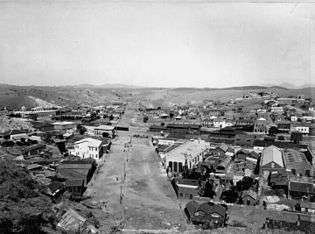
On August 27, 1918, the 10th Cavalry supported the 35th Infantry Regiment in a border skirmish in the border towns of Nogales, Arizona, and Nogales, Sonora, between U.S. military forces, Mexican Federal troops, and armed Mexican civilians (militia) in the Battle of Ambos Nogales. This was the only incident in which German military advisers allegedly fought along with Mexican soldiers against United States soldiers on North America soil during World War I.[16][25]
Battle of Ambos Nogales
The 35th Infantry Regiment was stationed at Nogales, Arizona, on August 27, 1918, when at about 4:10 p.m., a gun battle erupted unintentionally when a Mexican civilian attempted to pass through the border, back to Mexico, without being interrogated at the U.S. Customs house. After the initial shooting, reinforcements from both sides rushed to the border. On the Mexican side, the majority of the belligerents were angry civilians upset with the killings of Mexican border crossers by the U.S. Army along the vaguely defined border between the two cities during the previous year (the U.S. Border Patrol did not exist until 1924). For the Americans, the reinforcements were the 10th Cavalry, off-duty 35th Regiment soldiers, and militia. Hostilities quickly escalated, and several soldiers were killed, and others wounded on both sides, including the mayor of Nogales, Sonora, Felix B. Peñaloza (killed when waving a white truce flag/handkerchief with his cane). A cease-fire was arranged later after the US forces took the heights south of Nogales, Arizona.[16][25][42]
Due in part to the heightened hysteria caused by World War I, allegations surfaced that German agents fomented this violence and died fighting alongside the Mexican troops they led. U.S. newspaper reports in Nogales before the August 27, 1918, battle documented the departure of part of the Mexican garrison in Nogales, Sonora, to points south that August in an attempt to quell armed political rebels.[43][44][45]
Despite the Battle of Ambos Nogales controversy, the presence of the Buffalo Soldiers in the community left a significant impact on the border town. The famed jazz musician Charles Mingus was born in the Camp Stephen Little military base in Nogales in 1922, son of a Buffalo Soldier.[46] The African American population, centered on the stationing of Buffalo Soldiers such as the 25th Infantry in Nogales, was a significant factor in the community, though they often faced racial discrimination in the binational border community in addition to racial segregation at the elementary-school level in Nogales's Grand Avenue/Frank Reed School (a school reserved for black children).[47] The redeployment of the Buffalo Soldiers to other areas and the closure of Camp Little in 1933 initiated the decline of the African American community in Nogales.
World War II
.jpg)
Before World War II, the black 25th Infantry Regiment was based at Ft Huachuca. During the war, Ft Huachuca served as the home base of the Black 92nd and 93rd Infantry Divisions. The 9th and 10th Cavalry Regiments were mostly disbanded, and the soldiers were moved into service-oriented units, along with the entire 2nd Cavalry Division. The 92nd Infantry Division, the "Buffalo Division," served in combat during the Italian campaign. The 93rd Infantry Division—including the 25th Infantry Regiment—served in the Pacific theater.[48] Separately, independent Black artillery, tank, and tank destroyer battalions, as well as quartermaster and support battalions served in World War II. All of these units to a degree carried out the traditions of the Buffalo Soldiers.
Despite some official resistance and administrative barriers, Black airmen were trained and played a part in the air war in Europe, gaining a reputation for skill and bravery (see Tuskegee Airmen). In early 1945, after the Battle of the Bulge, American forces in Europe experienced a shortage of combat troops, so the embargo on using black soldiers in combat units was relaxed. The American Military History says:
Faced with a shortage of infantry replacements during the enemy's counteroffensive, General Eisenhower offered black soldiers in service units an opportunity to volunteer for duty with the infantry. More than 4,500 responded, many taking reductions in grade to meet specified requirements. The 6th Army Group formed these men into provisional companies, while the 12th Army Group employed them as an additional platoon in existing rifle companies. The excellent record established by these volunteers, particularly those serving as platoons, presaged major postwar changes in the traditional approach to employing Black troops.
Korean War and integration
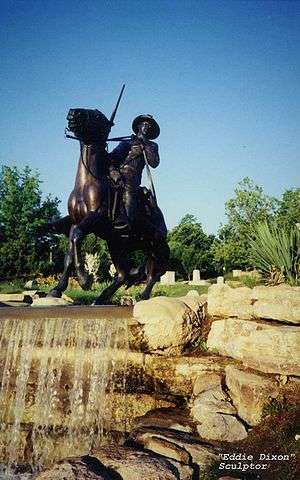
In 1948, President Harry Truman signed Executive Order 9981, which desegregated the military and marked the first federal piece of legislation that went against the societal norms implemented through Jim Crow laws. During the Korean War, black and white troops operated in integrated units for the first time.
The 24th Infantry Regiment saw combat during the Korean War and was the last segregated regiment to engage in combat. The 24th was deactivated in 1951, and its soldiers were integrated into other units in Korea. On December 12, 1951, the last Buffalo Soldier units, the 27th Cavalry and the 28th (Horse) Cavalry, were disbanded. The 28th Cavalry was inactivated at Assi-Okba, Algeria, in April 1944 in North Africa, and marked the end of the regiment.[49]
Monuments to the Buffalo Soldiers are in Kansas at Fort Leavenworth and Junction City.[50] Then–Chairman of the Joint Chiefs of Staff Colin Powell, who initiated the project to get a statue to honor the Buffalo Soldiers when he was posted as a brigadier general to Fort Leavenworth, was guest speaker for the unveiling of the Fort Leavenworth monument in July 1992.
Controversy
In the last decade, the employment of the Buffalo Soldiers by the United States Army in the Indian Wars has led some to call for the critical reappraisal of the African American regiments. In this viewpoint[51] the Buffalo Soldiers were used as mere shock troops or accessories to the forcefully expansionist goals of the U.S. government at the expense of the Native Americans and other minorities.[51][52]
Legacy
Historical markers
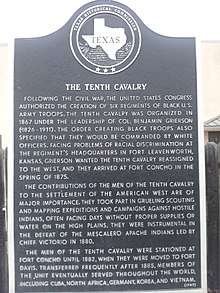
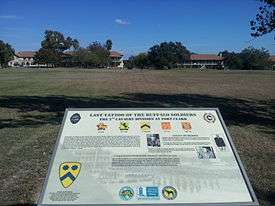
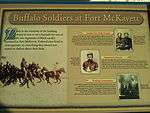

 Buffalo Soldiers serving at Fort Davis
Buffalo Soldiers serving at Fort Davis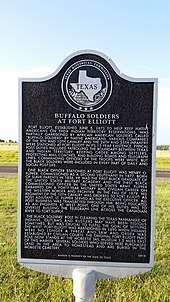 Fort Elliott
Fort Elliott
In popular culture
- The song and music of "Soul Saga (Song of the Buffalo Soldier)" has had several renditions. In 1974, it was produced by Quincy Jones in the album Body Heat.[53] In 1975, the album Symphonic Soul contained another variation and was released by Henry Mancini and his Orchestra.[54]
- The song "Buffalo Soldier", co-written by Bob Marley and King Sporty, first appeared on the 1983 album Confrontation. Many Jamaicans, especially Rastafarians like Marley, identified with the "Buffalo Soldiers" as an example of black men who performed with exceeding courage, honor, valor, and distinction in a field that was dominated by whites and persevered despite endemic racism and prejudice.[55]
- The song "Buffalo Soldier" by The Flamingos specifically refers to the 10th Cavalry Regiment. The song was a minor hit in 1970.[56] A cappella group The Persuasions remade the song on their album Street Corner Symphony. This version was produced by David Dashev and Eric Malamud.[57][58]
- A 1961 episode of the television series Rawhide ("Incident of the Buffalo Soldier", season 3, episode 10, aired January 6, 1961) was about a former top sergeant Buffalo Soldier stationed at Fort Wingate.[59]
- A 1964 episode of Rawhide ("Incident at Seven Fingers", season 6, episode 30, aired May 7, 1964) was about a top sergeant of Troop F, 110th Cavalry Regiment (played by William Marshall) who is accused of being a coward and a deserter. Other Buffalo Soldiers and an officer track him down.[60]
- A 1968 episode of television series The High Chaparral ("The Buffalo Soldiers", season 2, episode 10, aired November 22, 1968), starring Yaphet Kotto, had the 10th Cavalry, C Company called in to establish martial law at the request of the citizens of Tucson, to help relieve it from the grip of a crime boss.[61]
- The 1976 film Joshua, starring Fred Williamson, tells the story of a black soldier who, returned from fighting for the Union in the Civil War, becomes a bounty hunter determined to track down his mother's killers.[62]
- The 2017 Netflix series Godless has a camp of former Buffalo Soldiers that have turned to farming (their fighting days behind them). In the series it is explained that the term "Buffalo Soldier" is derived from when John Randall held off 70 Indians with only a pistol, having killed 13 of them while he sustained multiple wounds. This explanation however is largely fictitious.[63]
Medal of Honor recipients (1866–1918)
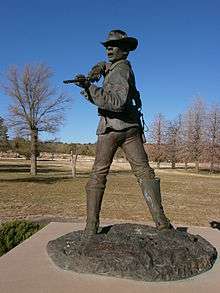
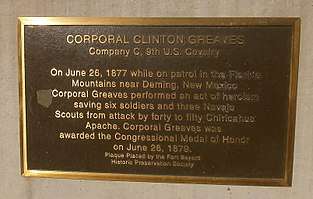
.jpg)
This list is of the officers and men who received the Medal of Honor due to service with the original units called "Buffalo Soldiers".
- Edward L. Baker, Jr.
- Dennis Bell
- Thomas Boyne
- Benjamin Brown
- George Ritter Burnett
- Louis H. Carpenter
- Powhatan Henry Clarke
- John Denny
- Pompey Factor
- Clinton Greaves
- Henry Johnson
- George Jordan
- Fitz Lee
- Isaiah Mays
- William McBryar
- Adam Paine
- Isaac Payne
- Thomas Shaw
- Emanuel Stance
- Freddie Stowers
- William H. Thompkins
- Augustus Walley
- George H. Wanton
- John Ward
- Moses Williams
- William Othello Wilson
- Brent Woods
Other prominent members
This list is of other notable African Americans who served in the original units as "Buffalo Soldiers" from 1866 to 1918.
- John Hanks Alexander
- Allen Allensworth
- Lewis Broadus
- Henry Ossian Flipper
- Edward W. Pearson, Sr.
- Charles Young
- Cathay Williams
See also
- Bicycle infantry
- Bisbee Riot
- Battle of the Saline River – one of the first combats of the 10th
- Black Seminoles (Cimarrones)
- Black Seminole Scouts
- List of African-American Medal of Honor recipients
- Military history of African Americans
- Racial segregation in the United States Armed Forces
- Camp Lockett
- Buffalo Soldier tragedy of 1877, also known as the "Staked Plains Horror"
- "Colonel" Charles Long
- The Buffalo Saga, memoirs of James H. Daugherty of the 92nd Infantry in World War II
- Tuskegee Airmen
- 1st Louisiana Native Guard
- 2nd Cavalry Division
- 92nd Infantry Division
- 93rd Infantry Division
- 366th Infantry Regiment
- 761st Tank Battalion
- 784th Tank Battalion
- MV Buffalo Soldier, a maritime prepositioning ship, used by the Military Sealift Command
- Tangipahoa African American Heritage Museum & Black Veteran Archives
- Buffalo Soldiers MC, a motorcycle club.
![]()
References
- Chap. CCXCIX. 14 Stat. 332 from "A Century of Lawmaking for a New Nation: U. S. Congressional Documents and Debates, 1774–1875". Library of Congress, Law Library of Congress. Retrieved March 26, 2012.
- Shaughnessy, Larry (September 19, 2005), Oldest Buffalo Soldier to be Buried at Arlington, CNN, retrieved April 24, 2007
- Lehmann, H., 1927, 9 Years Among the Indians, 1870-1879, Von Boeckmann-Jones Company, p. 121
- National Park Service, Buffalo Soldiers (PDF), archived from the original (PDF) on January 4, 2007, retrieved May 1, 2007
- Brief History (Buffalo Soldiers National Museum) (pdf), 2008, retrieved November 30, 2009
- The Smithsonian Institution, The Price of Freedom: Printable Exhibition, retrieved May 1, 2007
- DVD cover of the 1960 Western film Sergeant Rutledge (Issued in 2016 by the Warner Brothers Archive Collection.
- Schubert, Frank N. (1997). Black Valor: Buffalo Soldiers and the Medal of Honor, 1870-1898. Scholarly Resources Inc. pp. 4–5. ISBN 9780842025867.
- Schubert, Frank N. (1997). Black Valor: Buffalo Soldiers and the Medal of Honor, 1870-1898. Scholarly Resources Inc. p. 41. ISBN 9780842025867.
- Fort Concho National Historic Landmark, San Angelo, TX: Fort Concho NHL, retrieved January 2, 2009
- Schubert, Frank N. (1997). Black Valor: Buffalo Soldiers and the Medal of Honor, 1870-1898. Scholarly Resources Inc. p. 73. ISBN 9780842025867.
- "Medal of Honor Recipients: Indian Wars Period".
- Fields, Elizabeth Arnett. Historic Contexts for the American Military Experience Archived August 29, 2002, at the Wayback Machine
- Schubert, Frank N. "The Suggs Affray: The Black Cavalry in the Johnson County War". The Western Historical Quarterly, Vol. 4, No. 1 (January 1973), pp. 57–68.
- "10th Cavalry Squadron History". US Army. Archived from the original on November 27, 2005.
- Finely, James P. (1996), Buffalo Soldiers at Huachuca: The Battle of Ambo Nogales, Fort Huachuca, AZ: Huachuca Museum Society, p. Vol. 2, part 6, LCCN 93-206790, retrieved January 18, 2010
- Cunningham, Roger D. (October 16, 2015). "The Black "Immune" Regiments in the Spanish–American War". ArmyHistory.org.
- Cunningham, Roger (Summer 2001). ""We are an orderly body of men": Virginia's Black "Immunes" in the Spanish–American War" (PDF). Historic Alexandria Quarterly: 12.
- Clodfelter, Michael. Warfare and Armed Conflicts: A Statistical Encyclopedia of Casualties and Other Figures, 1494-2007
- Coston, Hilary (1971) [c. 1899]. The Spanish–American War volunteer. Freeport, NY: Books For Libraries Press. pp. 7.
- Glasrud, Bruce (2011). Brothers to the Buffalo Soldiers. University of Missouri Press. p. 5.
- Zinn, Howard. A People's History of the United States. p. 319. ISBN 9780062397348.
- Hoffman, Phillip W. David Fagen: Turncoat Hero. ISBN 9781939995254.
- Morey, Michael. An African American Renegade in the Philippine-American War. ISBN 9780299319403.
- Wharfield, Harold B., Colonel, USAF retired (1965), Tenth Cavalry and Border Fights, El Cajon, CA: Self published, pp. 85–97
- Johnson, Shelton Invisible Men: Buffalo Soldiers of the Sierra Nevada Archived October 10, 2006, at the Wayback Machine. Park Histories: Sequoia NP (and Kings Canyon NP), National Park Service. Retrieved: 2007-05-18.
- Leckie, William H. (1967), The Buffalo Soldiers: A Narrative of the Black Cavalry in the West, Norman, OK: University of Oklahoma Press, LCCN 67015571
- Wallis, O. L. (September 1951), "Yosemite's Pioneer Arboreetum" (PDF), Yosemite Nature Notes, Yosimite Natural History Association, Inc., XXX, Number 9, p. 83, retrieved May 5, 2010
- Johnson, Shelton, Shadows in the Range of Light, archived from the original on May 12, 2007, retrieved April 24, 2007
- Buckley, Gail Lumet, American Patriots: The Story of Blacks in the Military from the Revolution to Desert Storm, Random House; 1st edition (May 22, 2001).
- Brandon O'Connor (September 5, 2018) Honoring Buffalo Soldiers legacy with annual ceremony
- Randy Steffen, page 72 "The Horse Soldier, Volume IV, 1917-1943", University of Oklahoma Press 1979
- Christian, Garna (August 17, 2001), Handbook of Texas Online: Rio Grande City, Texas, retrieved April 24, 2007
- Christian, Garna (February 17, 2005), Handbook of Texas Online: Brownsville, Texas, retrieved April 24, 2007
- Haynes, Robert (April 6, 2004), Handbook of Texas Online: Houston, Texas, retrieved April 24, 2007
- The Officer Down Memorial Page (Police Officer Rufus E. Daniels), archived from the original on September 27, 2007, retrieved April 24, 2007
- Schubert, Frank N. (1997). Black Valor: Buffalo Soldiers and the Medal of Honor, 1870-1898. Scholarly Resources Inc. pp. 164–165. ISBN 9780842025867.
- http://www.nps.gov/pwso/honor/pershing.htm Archived September 15, 2007, at the Wayback Machine
- Frank E. Vandiver, Black Jack: The Life and Times of John J. Pershing – Volume I (Texas A&M University Press, Third printing, 1977) ISBN 0-89096-024-0, 67.
- Bak, Richard, Editor. "The Rough Riders" by Theodore Roosevelt. Page 172. Taylor Publishing, 1997.
- 317th Engineer Battalion
- Clendenen, Clarence (1969), Blood on the Border: The United States Army and the Mexican Irregulars, New York: Macmillan, ISBN 978-0-02-526110-5
- General DeRosey C. Cabell, "Report on Recent Trouble at Nogales, 1 September 1918", Battle of Nogales 1918 Collection, Pimeria Alta Historical Society (Nogales, AZ). See also DeRosey C. Cabell, "Memorandum for the Adjutant General: Subject: Copy of Records to be Furnished to the Secretary of the Treasury. 30 September 1918", Battle of Nogales 1918 Collection, Pimeria Alta Historical Society (Nogales, AZ). Furthermore, an investigation by Army officials from Fort Huachuca, Arizona, could not substantiate accusations of militant German agents in the Mexican border community and instead traced the origins of the violence to the abuse of Mexican border crossers in the year before the Battle of Ambos Nogales. The main result of this battle was the building of the first permanent border fence between the two cities of Nogales.
- "Military Commanders Hold Final Conference Sunday", Nogales Evening Daily Herald (Nogales, AZ), September 2, 1918; Daniel Arreola, "La Cerca y Las Garitas de Ambos Nogales: A Postcard Landscape Exploration", Journal of the Southwest, vol. 43 (Winter 2001), pp. 504-541. Though largely unheard of in the U.S. (and even within most of Mexico), the municipal leaders of Nogales, Sonora, successfully petitioned the Mexican Congress in 1961 to grant the Mexican border city the title of "Heroic City", leading to the community's official name, Heroica Nogales, a distinction shared with other Mexican cities such as Heroica Huamantla, Tlaxcala, and Heroica Veracruz, Veracruz, communities that also saw military confrontation between Mexicans and U.S. military forces.
- Carlos F. Parra, "Valientes Nogalenses: The 1918 Battle Between the U.S. and Mexico That Transformed Ambos Nogales", Journal of Arizona History, Vol. 51 (Spring 2010), p. 26.
- "Mingus Biography - Charles Mingus: The Official Site".
- Francisco Castro, "Overcoming Prejudice: Limitations Against Blacks in Nogales Did Not Stop Them from Accomplishments", In the Steps of Esteban, Tucson's African American Heritage.
- Hargrove, Hondon B. (1985), Buffalo Soldiers in Italy: Black Americans in World War II, Jefferson, NC: McFarland & Company, ISBN 0-89950-116-8
- The 28th Cavalry: The U.S. Army's Last Horse Cavalry Regiment, archived from the original on December 20, 2007, retrieved April 24, 2007
- Services – Buffalo Soldier Monument, archived from the original on June 27, 2007, retrieved April 24, 2007
- The shame of the Buffalo Soldiers, retrieved July 24, 2007
- The Buffalo Soldier of the West and the Elimination of the Native American Race, retrieved July 24, 2007
- Soul Saga (Song of the Buffalo Soldier), Jones, Quincy, 1974, A&M. 1988, Album Body Heat. ASIN: B000W0248E
- Soul Saga (Song of the Buffalo Soldier), Mancini, Henry, 1975, RCA CPL1-0672 (Quadraphonic) album Symphonic Soul".
- Black Heretics, Black Prophets: Radical Political Intellectuals – Bogues, Anthony, Page 198, via Google Books. Accessed 2008-06-28.
- Whitburn, Joel (2000). Top Pop Singles 1955-1999. Menomonee Falls, WI: Record Research, Inc. p. 227. ISBN 0-89820-140-3.
- Buffalo Soldier, The Persuasions, 1971, Capitol Records. 1993, Album Street Corner Symphony. ASIN: B0000008N7
- 'Buffalo Soldier' by The Persuasions on Discogs
- "Incident of the Buffalo Soldier" on tv.com and The Rawhide Trail. Retrieved June 13, 2012.
- "Incident at Seven Fingers" on tv.com and The Rawhide Trail. Retrieved May 16, 2014.
- "The High Chaparral Episode 2.36".
- Ian Jane (August 16, 2011). "Cut-Throats Nine / Joshua". DVD Talk.
- The 13 Indians weren't killed by Randall, but rather by the soldiers coming to rescue him. While Indians started to use the term Buffalo Soldiers around that time, there is no direct connection to the incident with Randall. See for instance: William H. Leckie, Shirley A. Leckie: The Buffalo Soldiers: A Narrative of the Black Cavalry in the West. University of Oklahoma Press, 2012, ISBN 9780806183893, pp. 26-27
Further reading
- Billington, Monroe Lee. New Mexico's Buffalo Soldiers, 1866–1900 (University Press of Colorado, 1991)
- Downey, Fairfax. The Buffalo Soldiers in the Indian Wars (McGraw-Hill, 1969)
- Field, Ron, and Alexander M. Bielakowski. Buffalo Soldiers: African American Troops in the US Forces, 1866–1945 (Osprey Pub., 2008)
- Glasrud, Bruce A, and Michael N. Searles, eds. Buffalo Soldiers in the West: A Black Soldiers Anthology (Texas A&M University Press, 2007) ISBN 978-1585446209
- Horne, Gerald. Black and Brown: African Americans and the Mexican Revolution, 1910–1920 (New York University Press, 2005) ISBN 978-0814736739
- Kenner, Charles L. Buffalo Soldiers and Officers of the Ninth Cavalry, 1867–1898: Black and White Together (University of Oklahoma Press, 1990) ISBN 978-0806131580
- Leckie, William H., and Shirley A. Leckie. The Buffalo Soldiers: A Narrative of the Black Cavalry in the West (University of Oklahoma Press, 2012)
- Schubert, Frank N. (1997). Black Valor: Buffalo Soldiers and the Medal of Honor, 1870-1898. Scholarly Resources Inc. ISBN 9780842025867.
- Schubert, Frank N. Buffalo Soldiers, Braves, and the Brass: The Story of Fort Robinson, Nebraska (White Mane Publishing Company, 1993)
- Smith, Sherry L. "Lost Soldiers: Re-searching the Army in the American West." Western Historical Quarterly (1998): 149–163. in JSTOR
External links
| Wikimedia Commons has media related to Buffalo soldiers. |
- Buffalo Soldiers at San Juan Hill
- Buffalo Soldier Monument – Fort Leavenworth, Kansas
- Buffalo Soldier National Museum
- Photograph Gallery of Buffalo Soldiers On the Eve of War (World War II) at the United States Army Center of Military History
- Buffalo Soldiers from the Handbook of Texas Online
- shadowsoldier.wilderness.net, a website devoted to remembering the contributions of the buffalo soldiers of the Sierra Nevada, by Park Ranger Shelton Johnson, Yosemite National Park
- A Path to Lunch Liberation Day and the Liberation of America, Buffalo Soldiers in Lunigiana and Versilia, Italy.
- Engagements by the Buffalo Soldiers and Seminole-Black Indian Scouts
- Buffalo Soldiers during WW2 Captain Merrel Moody instructs Privates Enichel Kennedy, Oscar Davis, B. D. Kroninger and Will Johnson of Infantry School Stables, on the proper way to clean a saddle. Date: July 25, 1941.
_troops_return_colors_to_Union_League_Club._Men_draw_._._._-_NARA_-_533590.tif.jpg)